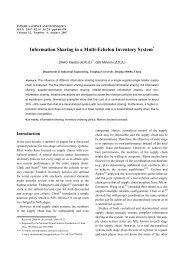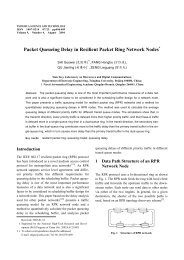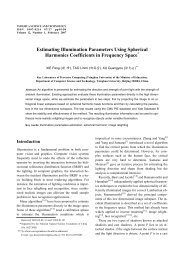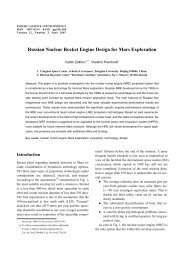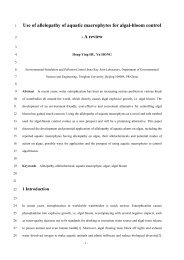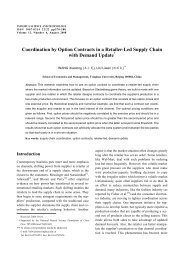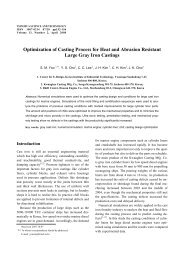Parameter Uncertainty in CGE Modeling of the Macroeconomic Impact
Parameter Uncertainty in CGE Modeling of the Macroeconomic Impact
Parameter Uncertainty in CGE Modeling of the Macroeconomic Impact
Create successful ePaper yourself
Turn your PDF publications into a flip-book with our unique Google optimized e-Paper software.
WANG Can (王 灿) et al:<strong>Parameter</strong> <strong>Uncerta<strong>in</strong>ty</strong> <strong>in</strong> <strong>CGE</strong> Model<strong>in</strong>g <strong>of</strong>… 623<br />
Table 2 Order <strong>of</strong> <strong>the</strong> sensitivities <strong>of</strong> elasticities to <strong>the</strong> <strong>CGE</strong> model outputs<br />
Top ten sensitive elasticities Top ten <strong>in</strong>sensitive elasticities<br />
To carbon tax rate To GDP loss rate To carbon tax rate To GDP loss rate<br />
Elasticity IMαi Elasticity IMαi Elasticity IMαi Elasticity IMαi<br />
E ke(2) 0.36 E ee(2) 0.36 E id(5) 0.02 E ed(9) 0.02<br />
E ee(2) 0.31 E ee(10) 0.19 E ee(5) 0.02 E ee(1) 0.02<br />
E ke(10) 0.26 E ee(7) 0.10 E ke(4) 0.02 E ke(9) 0.02<br />
E ke(6) 0.16 E ke(2) 0.09 E id(9) 0.02 E ed(1) 0.02<br />
E ee(10) 0.12 E ke(10) 0.09 E ed(10) 0.02 E ed(7) 0.03<br />
E ke(3) 0.11 E ee(6) 0.09 E ed(7) 0.03 E ed(4) 0.03<br />
E cl(2) 0.10 E cl(7) 0.09 E ed(9) 0.03 E id(10) 0.03<br />
E ee(6) 0.09 E ee(9) 0.09 E ee(1) 0.03 E cl(1) 0.04<br />
E cl(10) 0.08 E id(4) 0.09 E ke(9) 0.03 E ee(4) 0.04<br />
E ed(6) 0.08 E ed(6) 0.08 E ed(4) 0.03 E id(7) 0.04<br />
Notes: Figures at <strong>the</strong> end <strong>of</strong> <strong>the</strong> code <strong>in</strong>dicate <strong>the</strong> sector: 1, Agriculture; 2, Heavy <strong>in</strong>dustry; 3, Light <strong>in</strong>dustry; 4, Transportation; 5, Construction;<br />
6, Service; 7, Electricity; 8, Coal; 9, Oil, and 10, Natural gas.<br />
Table 2 shows that <strong>the</strong> most sensitive elasticity parameters<br />
are generally Eke (elasticity substitution between<br />
capital and energy aggregate) and Eee (elasticity<br />
substitution between different energy sources). The<br />
elasticity parameters <strong>in</strong> <strong>the</strong> <strong>in</strong>ternational trade function<br />
(i.e, Eed and Eid) have relatively weak effects on <strong>the</strong><br />
outputs as shown <strong>in</strong> <strong>the</strong> top ten <strong>in</strong>sensitive elasticities<br />
<strong>in</strong> Table 2. When consider<strong>in</strong>g sectoral elasticities, <strong>the</strong><br />
elasticity parameters <strong>in</strong> heavy <strong>in</strong>dustry (Sector 2), service<br />
(Sector 6), and natural gas sector (Sector 10) are<br />
<strong>the</strong> most significant contributors listed <strong>in</strong> <strong>the</strong> left side <strong>of</strong><br />
Table 2. That means <strong>the</strong> elasticities <strong>of</strong> <strong>the</strong>se three sectors<br />
cause <strong>the</strong> most variations <strong>in</strong> <strong>the</strong> outputs. The elasticities<br />
<strong>in</strong> <strong>the</strong> agriculture, transportation, and oil production sectors<br />
(Sectors 1, 4, and 9) have little <strong>in</strong>fluence on <strong>the</strong> output<br />
as shown on <strong>the</strong> right side <strong>of</strong> Table 2.<br />
4 Conclusions<br />
Computable general equilibrium model<strong>in</strong>g has become<br />
an effective technique for evaluat<strong>in</strong>g a wide range <strong>of</strong><br />
policy questions. While uncerta<strong>in</strong>ties about <strong>the</strong> <strong>in</strong>put<br />
values <strong>in</strong> a <strong>CGE</strong> model may limit <strong>the</strong> credibility <strong>of</strong> its<br />
conclusions, relatively few applications have explicitly<br />
treated <strong>the</strong> uncerta<strong>in</strong>ties. This paper describes formal<br />
methods for assess<strong>in</strong>g this type <strong>of</strong> uncerta<strong>in</strong>ties and illustrates<br />
its use <strong>in</strong> a TED<strong>CGE</strong> model applied to a carbon<br />
tax policy issue. The method relies on build<strong>in</strong>g<br />
probability density functions <strong>of</strong> <strong>the</strong> <strong>CGE</strong> model output<br />
us<strong>in</strong>g crude Monte Carlo experiments. In contrast to<br />
<strong>the</strong> traditional op<strong>in</strong>ions, <strong>the</strong> results <strong>in</strong>dicate that not<br />
only can uncerta<strong>in</strong>ty <strong>in</strong> <strong>the</strong> <strong>CGE</strong> model be described<br />
given full statistical <strong>in</strong>formation on <strong>the</strong> <strong>in</strong>put parameters,<br />
but that <strong>the</strong> uncerta<strong>in</strong>ties have important quantitative<br />
and qualitative consequences. The <strong>in</strong>put uncerta<strong>in</strong>ty<br />
can be reduced to some extent through <strong>the</strong> <strong>CGE</strong><br />
model<strong>in</strong>g procedure. The results also <strong>in</strong>dicate that <strong>the</strong><br />
<strong>CGE</strong> model results were sensitive to only some <strong>of</strong> <strong>the</strong><br />
parameters when <strong>the</strong> critical parameters for different<br />
endogenous variables are varied. The carbon tax level<br />
correspond<strong>in</strong>g to a predef<strong>in</strong>ed carbon reduction rate <strong>in</strong><br />
TED<strong>CGE</strong>, for example, was quite sensitive to both <strong>the</strong><br />
capital-energy substitution elasticity and <strong>the</strong> <strong>in</strong>ter-fuel<br />
substitution elasticity <strong>in</strong> <strong>the</strong> production sector, while<br />
<strong>the</strong> key parameter affect<strong>in</strong>g <strong>the</strong> GDP reduction rate<br />
was only <strong>the</strong> <strong>in</strong>ter-fuel substitution elasticity. The results<br />
also show that <strong>the</strong> heavy <strong>in</strong>dustry and electricity<br />
sectors are <strong>the</strong> most important sectors affect<strong>in</strong>g <strong>the</strong><br />
carbon tax level.<br />
Acknowledgements<br />
The manuscript was mostly prepared dur<strong>in</strong>g <strong>the</strong> first author’s<br />
stay as a guest researcher at <strong>the</strong> Energy Project <strong>of</strong> International<br />
Institute for Applied Systems Analysis (IIASA). The authors<br />
gratefully acknowledge Dr. Leo Schrattenholzer, Dr. Leonardo<br />
Barreto, and Dr. Ji Zou for <strong>the</strong>ir valuable comments.



